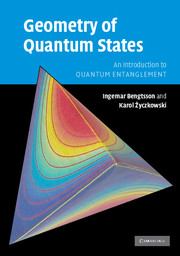Book contents
- Frontmatter
- Contents
- Preface
- 1 Convexity, colours and statistics
- 2 Geometry of probability distributions
- 3 Much ado about spheres
- 4 Complex projective spaces
- 5 Outline of quantum mechanics
- 6 Coherent states and group actions
- 7 The stellar representation
- 8 The space of density matrices
- 9 Purification of mixed quantum states
- 10 Quantum operations
- 11 Duality: maps versus states
- 12 Density matrices and entropies
- 13 Distinguishability measures
- 14 Monotone metrics and measures
- 15 Quantum entanglement
- Epilogue
- Appendix 1 Basic notions of differential geometry
- Appendix 2 Basic notions of group theory
- Appendix 3 Geometry: do it yourself
- Appendix 4 Hints and answers to the exercises
- References
- Index
5 - Outline of quantum mechanics
Published online by Cambridge University Press: 27 August 2009
- Frontmatter
- Contents
- Preface
- 1 Convexity, colours and statistics
- 2 Geometry of probability distributions
- 3 Much ado about spheres
- 4 Complex projective spaces
- 5 Outline of quantum mechanics
- 6 Coherent states and group actions
- 7 The stellar representation
- 8 The space of density matrices
- 9 Purification of mixed quantum states
- 10 Quantum operations
- 11 Duality: maps versus states
- 12 Density matrices and entropies
- 13 Distinguishability measures
- 14 Monotone metrics and measures
- 15 Quantum entanglement
- Epilogue
- Appendix 1 Basic notions of differential geometry
- Appendix 2 Basic notions of group theory
- Appendix 3 Geometry: do it yourself
- Appendix 4 Hints and answers to the exercises
- References
- Index
Summary
Quantum mechanics is like a pot: it is almost indestructible and extremely rigid, but also very flexible because you can use any ingredients for your soup.
Göran LindbladQuantum mechanics
Although our first four chapters have been very mathematical, quantum mechanics has never been very far away. Let us recall how the mathematical structure of quantum mechanics is usually summarized at the end of a first course in the subject. First of all the pure states are given by vectors in a Hilbert space. If that Hilbert space is finite dimensional it is simply the vector space equipped with a scalar product of the particular kind that we called a Hermitian form in Eq. (3.82). Actually a pure state corresponds to an entire equivalence class of vectors; this is usually treated in such a way that the vectors are normalized to have length one and afterwards vectors differing by an overall phase eiø are regarded as physically equivalent. In effect then the space of pure states is the complex projective space; as always in this book n = N – 1. The notation used in quantum mechanics differs from what we have used so far. We have denoted vectors in by Zα, while in quantum mechanics they are usually denoted by a ket vector. We can think of the index α as just a label telling us that Zα is a vector, and then these two notations are in fact exactly equivalent.
- Type
- Chapter
- Information
- Geometry of Quantum StatesAn Introduction to Quantum Entanglement, pp. 135 - 155Publisher: Cambridge University PressPrint publication year: 2006



